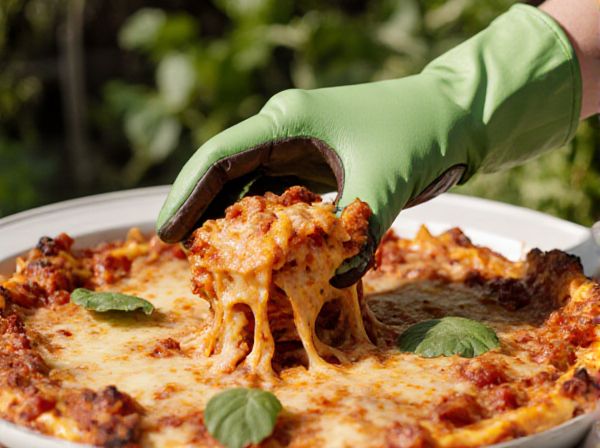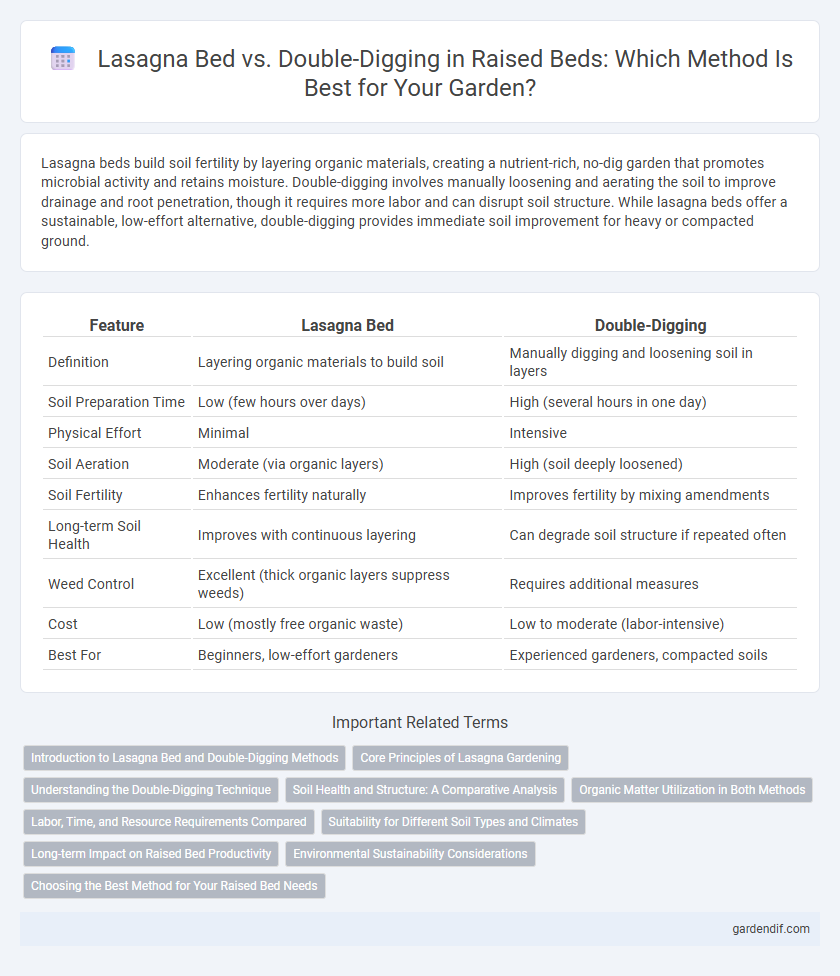
Lasagna bed vs Double-digging Illustration
Lasagna beds build soil fertility by layering organic materials, creating a nutrient-rich, no-dig garden that promotes microbial activity and retains moisture. Double-digging involves manually loosening and aerating the soil to improve drainage and root penetration, though it requires more labor and can disrupt soil structure. While lasagna beds offer a sustainable, low-effort alternative, double-digging provides immediate soil improvement for heavy or compacted ground.
Table of Comparison
| Feature | Lasagna Bed | Double-Digging |
|---|---|---|
| Definition | Layering organic materials to build soil | Manually digging and loosening soil in layers |
| Soil Preparation Time | Low (few hours over days) | High (several hours in one day) |
| Physical Effort | Minimal | Intensive |
| Soil Aeration | Moderate (via organic layers) | High (soil deeply loosened) |
| Soil Fertility | Enhances fertility naturally | Improves fertility by mixing amendments |
| Long-term Soil Health | Improves with continuous layering | Can degrade soil structure if repeated often |
| Weed Control | Excellent (thick organic layers suppress weeds) | Requires additional measures |
| Cost | Low (mostly free organic waste) | Low to moderate (labor-intensive) |
| Best For | Beginners, low-effort gardeners | Experienced gardeners, compacted soils |
Introduction to Lasagna Bed and Double-Digging Methods
Lasagna bed gardening involves layering organic materials like leaves, compost, and grass clippings to create nutrient-rich soil without extensive digging. Double-digging is a manual soil preparation technique that loosens two layers of soil to improve aeration and root penetration. Lasagna beds require less physical effort and gradually build soil fertility, while double-digging offers immediate soil structure improvement for planting.
Core Principles of Lasagna Gardening
Lasagna gardening builds soil fertility by layering organic materials like compost, straw, and kitchen scraps, promoting microbial activity and moisture retention. Unlike double-digging, which involves deep soil excavation to aerate and loosen soil, lasagna beds emphasize no-till principles that preserve soil structure and reduce labor. This method enhances soil health naturally by creating a rich, nutrient-dense environment that supports plant growth over time.
Understanding the Double-Digging Technique
Double-digging is a soil preparation technique that improves aeration, drainage, and root penetration by manually loosening two layers of soil to a depth of approximately 24 inches. Unlike lasagna beds, which build fertility through layered organic matter on the soil surface, double-digging involves physically turning and breaking up the soil for enhanced structure and nutrient availability. This method is particularly effective for compacted or clay-heavy soils, promoting healthier plant growth and increased crop yields.
Soil Health and Structure: A Comparative Analysis
Lasagna beds improve soil health by layering organic materials that decompose to enrich soil structure and nutrient availability, promoting microbial activity and moisture retention. Double-digging enhances soil aeration and root penetration by loosening deeper soil layers, but may disrupt soil ecosystems and requires more labor. Comparing both, lasagna beds offer a sustainable, low-disturbance method for long-term soil vitality, whereas double-digging provides immediate structural benefits but risks soil compaction and erosion if done improperly.
Organic Matter Utilization in Both Methods
Lasagna beds maximize organic matter utilization by layering compost, mulch, and nutrient-rich materials directly on the surface, promoting rapid decomposition and soil fertility enhancement. Double-digging incorporates organic matter deeply into the soil by manually loosening and mixing layers, improving aeration and root penetration but requiring more labor. Both methods enrich soil organic content, but lasagna beds accelerate topsoil formation organically, while double-digging integrates amendments for long-term structural improvement.
Labor, Time, and Resource Requirements Compared
Lasagna beds require significantly less labor and time than double-digging, as they involve layering organic materials without the need for intensive soil turning. The process of double-digging demands considerable physical effort and careful soil aeration, extending preparation time and increasing labor costs. Resource-wise, lasagna beds utilize readily available compostable materials, minimizing soil disturbance, whereas double-digging relies on substantial manual digging and soil amendment inputs.
Suitability for Different Soil Types and Climates
Lasagna beds excel in improving poor or compacted soils by layering organic materials that decompose over time, making them ideal for heavy clay or sandy soils and varying climates due to their moisture retention and aeration benefits. Double-digging is best suited for well-drained soils and temperate climates where deep soil loosening enhances root growth but requires significant labor and is less effective in extremely dry or compacted soils. Choosing between lasagna beds and double-digging depends on initial soil condition, climate moisture levels, and gardener effort preferences.
Long-term Impact on Raised Bed Productivity
Lasagna beds improve long-term raised bed productivity by layering organic matter that decomposes slowly, enriching soil structure and microbial activity over time. Double-digging aerates soil deeply and boosts initial nutrient availability but requires frequent labor and maintenance to sustain productivity. Over multiple growing seasons, lasagna beds foster continuous soil fertility, making them more sustainable for extended raised bed cultivation.
Environmental Sustainability Considerations
Lasagna beds maximize environmental sustainability by layering organic materials that improve soil fertility naturally, reducing the need for chemical fertilizers and minimizing soil disturbance. In contrast, double-digging, while effective for aerating soil, can disrupt soil microbial ecosystems and lead to increased erosion if not managed carefully. Prioritizing lasagna beds supports carbon sequestration and nutrient recycling, fostering a healthier, more resilient garden ecosystem.
Choosing the Best Method for Your Raised Bed Needs
Lasagna beds and double-digging offer distinct benefits for raised bed gardening, with lasagna beds relying on layered organic matter to improve soil fertility and moisture retention over time. Double-digging involves mechanically loosening two layers of soil to enhance root penetration and aeration, providing immediate soil restructuring benefits. Selecting the best method depends on your garden's current soil condition, desired effort level, and long-term soil health goals.
Lasagna bed vs Double-digging Infographic

 gardendif.com
gardendif.com